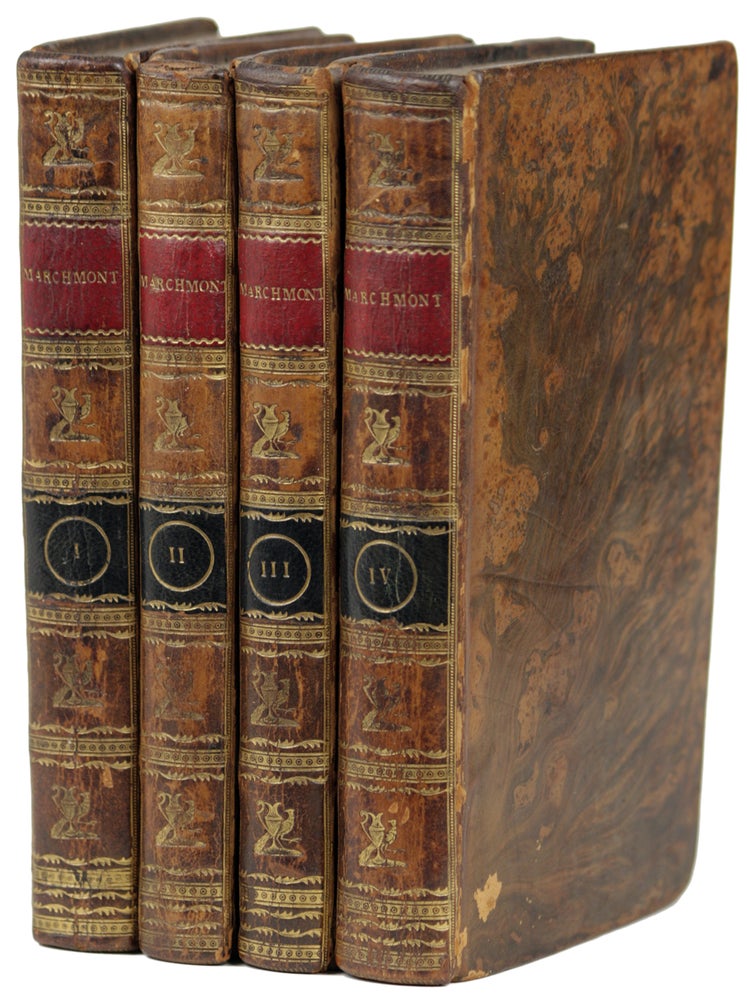MARCHMONT: A NOVEL ... IN FOUR VOLUMES ...
London: Printed by and for Sampson Low, Berwick Street, Soho, 1796. 12mo, four volumes: pp. [i-v] vi-xvi [1] 2-309 [310-312: blank]; [i-ii] [1] 2-256; [i-ii] [1] 2-268; [i-iv] [1] 2-442 [443-444: ads], full eighteenth-century tree calf, spine richly tooled in gold, red leather title pieces, black leather number pieces, gauffered edges. First edition. "In MARCHMONT, Mrs. Smith achieved a synthesis of domestic and Gothic fiction, a convergence of the imaginary horrors of Gothic fantasy and the real horrors of domestic life during an era of revolution and reaction. In one of the sequences of action, she also included her philosophical reservations about the tyrannical direction of the French Revolution, a didactic strain she had previously introduced in THE BANISHED MAN (1794). The title, 'Marchmont' refers to a family, to a young man who attempts to maintain the decent family name against ruthless schemers, and to the decaying family mansion at Eastwoodleigh, the habitat of ghosts and other unnatural phenomena. To the 'haunted' house of Marchmont comes the heroine, Althea Dacres, sentenced by her angry father to be incarcerated within this foreboding ruin until she consents to marry her father's monstrous lawyer, the coarse and brutal Mr. Mohun. Unknown to Althea, young Mr. Marchmont has also taken up secret residence in the ruined home in order to avoid a swarm of avaricious creditors directed by one of Mrs. Smith's most memorable Gothic demons, the attorney, Mr. Vampyre. The concentration of evil in a diabolically intelligent male character reflects Mrs. Smith's acceptance of the need for this type of character in making her work marketable for a Gothic readership. Vampyre foreshadows Dickens's voracious lawyers and inhuman professionals who feed off the monetary misfortunes of good characters, -- Mr. Tulkinghorn in BLEAK HOUSE (1852-1853) would be an analogous personality. Althea experiences an array of supernatural sounds and sights, all caused by the hidden fugitive, Marchmont. Discovered at last, Marchmont and Althea form a lover's alliance, then flee from the ruined castle together in what must have been a satisfying sequence of images for Gothic readers, the two worthy victims released from the chamber of horrors. But more separations and distresses lie ahead for the young lovers, for in Mrs. Smith's vision, the return from the Gothic world to the social world brings no assurance of safety. Marchmont goes to France just as the Terror is reaching its pinnacle, witnesses all the horrors, loses his Rousseauistic idealism, experiments with country living, and finally reenters repressive English society, even if this means surrendering to Vampyre and his brood of bill collectors. Meanwhile, Althea's own sufferings continue upon the death of her father and the abrogation of her inheritance by Mohun. But a stroke of sudden wealth for both Marchmont and Althea, a ploy used on countless occasions by the Victorian novelists to extricate their good characters, transforms a tense and sad tale into a success story. Vampyre's vicious campaign to ruin Marchmont is blunted when Mr. Desborough, a benevolent creditor who despises the methods of Vampyre, comes forward with a bequest. Althea also obtains a large inheritance from an equally mysterious source. In this happy conclusion, we can see Charlotte Smith's concession to a mandatory narrative formula. Her strongest achievement in MARCHMONT and elsewhere is her conception of the novel as medium for thinking through and testing the volatile ideas of a dangerous decade. To this end, she understood that the most appealing social theories often have a darker side that could be best expressed through the various modes of the Gothic." - Frank, The First Gothics 425. Summers, A Gothic Bibliography, p. 399. Garside, Raven and Schöwerling 1796: 82. Bookplate of Sir Thomas Hesketh and small library label of the Easton Neston Library affixed to the paste-down of each volume. Calf a bit rubbed along outer joints, leaf G1 of volume 1 has a tiny hole in lower margin, leaf F1 of volume 2 has a chip from the lower right margin with loss of "e" in catchword, L1 of volume 4 has a closed tear to lower margin. The half title leaves called for in volumes 1 and 4 are present, as is the final blank in volume 1 and terminal leaf of publisher's advertisements in volume 4. A lovely copy in an attractive contemporary binding. (19314). Item #19314
Price: $3,500.00

